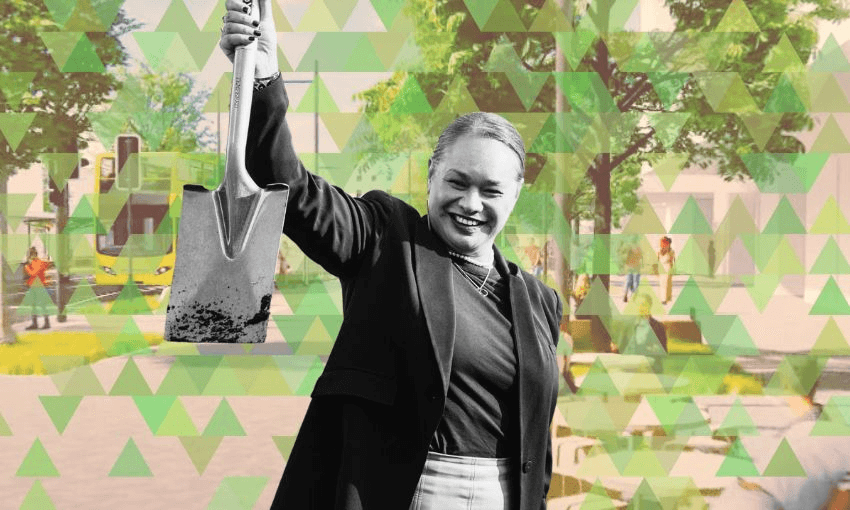After nearly a decade of let’s-and-let’s-not, Wellington City Council has officially commenced work on the Golden Mile upgrade. It’s hard to imagine why city dwellers wouldn’t want a better place to live, argues Lyric Waiwiri-Smith.
The truck carrying a load of port-a-loos had stopped at the least opportune time. Idling at the intersection between Courtenay Place and Cambridge Terrace on Monday morning, the green machine rolled past the city councillors circling a traffic island and, by the time they had stopped, so had the truck, sitting in the money shot right behind mayor Tory Whanau. The sod turning for the first stage of the Golden Mile upgrade needed to wait another 30 seconds for the truck to get the green light and go, but a handful of seconds is nothing against the backdrop of a nearly decade-long wait.
Using a shovel already caked with a bit of mud, Whanau gently dug into the moist earth, then curled the blade upwards and lifted the spade high in the air, letting the morning sunlight gleam off it – the silver lining of a multimillion-dollar headache for some, a long-overdue upgrade to many more.
After nine years of council in-fighting, foiled attempts to loosen the purse strings and bite-back from businesses and central government, the Golden Mile was officially under way. The councillors who had fought to kill construction hadn’t hidden in the shrubbery for their moment to swoop in and swipe Whanau’s spade, as our Wellington editor Joel MacManus had predicted they might.
There was no sign of councillor Tony Randle rushing down the street to call a last-minute motion, and councillor Nicola Young avoided dragging a business owner out of the bushes with her. The council, as a council should, simply got on with it, a rare feat for a bunch of New Zealanders in local government.
It’s hard to imagine why those living in a city constantly plagued by bad headlines – whether they concern broken pipes, money woes, a vibecession, or just straight up asking whether Wellington is in the shit – wouldn’t want their city to get better. Whether the Golden Mile is the antidote to Wellington’s ailments will be seen within the next five years or so, when construction has finally concluded – but it’s either take this, or let things stay the way they are.
You’d be hard pressed to walk through the capital’s streets and find a Wellingtonian who a) doesn’t think at least one block of the 2.43km of roads that make up the Golden Mile (don’t ask me why they choose that name with the information available) needs a facelift, and b) is somehow ignorant to the fact that Wellington’s inability to get itself moving has made it the butt of the rest of the country’s jokes.
The Golden Mile covers Courtenay Place, Manners Street, Willis Street and Lambton Quay, all main roads in the city and all in varying states of shambles. Courtenay Place, the nightlife hub, is trendy at the Mt Vic end and scummy at the Manners Street end, where the dilapidated, piss-soaked and grime-covered Reading Cinemas (due to be reopened later this year) sits. Then there is Manners Street itself, the subject of weekly Vic Deals horror stories, where there’s little to see except for some crime here and there.
Meanwhile, Willis Street is thriving. There are food and retail options, and as the connector between bureaucratic Lambton Quay and chill-vibes Cuba Street, there’s plenty of foot traffic (the entire “mile” is also at the heart of the city’s public transport system, which 95% of all of the city’s buses run through). And Lambton Quay is Lambton Quay – a hotspot on work days during work hours, but at any other time, essentially a ghost town.
The city council’s official line is that the Golden Mile works – which include pedestrianising the streets, more greenery, a new bike lane, widened footpaths and slip-safe paving – will help to “revitalise” Wellington and “create a vibrant, accessible, and thriving environment”. If you are too jaded by bureaucrat-speak to understand what this all means, here is a quick breakdown:
Widened footpaths will mean you won’t have to angrily shove past the slow-moving mobs on Lambton. Better paving means you won’t fall on your ass after a night out on the booze on Courtenay. Seeing a tree in an urban space will remind you to touch grass. God forbid we want anything more.
The whole song and dance is reminiscent of where Auckland stood about 10 years ago, around the same time the Golden Mile was conceptualised, when the City of Sails was staring down the barrel of the City Rail Link. An underground train line, in little old Auckland city? Dare we dream of a reality that makes us a real city? Dare we want more from this life? Nearly 10 years on, Aucklanders will soon reap the benefits of an improved public transport system – Wellingtonians can’t even decide if a cycleway is too controversial.
“Projects like this happen all over the world all the time, and it generates negativity – that is the norm,” Whanau told The Spinoff. “Change is hard, but people will love it.”
Things take time. Things also cost money. Things that take time and cost money are hard to imagine the end result of. But perhaps in five years, as you seek refuge from the sun under the new green foliage on Courtenay Place, the painful Golden Mile decision-making process will come back as a flicker of a bad dream. You’ll try to clear your head with a bike ride down a polished Manners Street, stop at the end of Lambton Quay, shock yourself by discovering there are actually other people here too, walk out onto the car-less street, raise your hands to the sky and scream that if you can make it here, you can make it anywhere.



